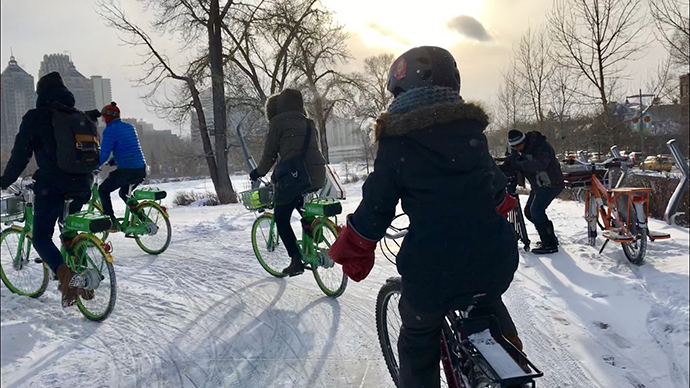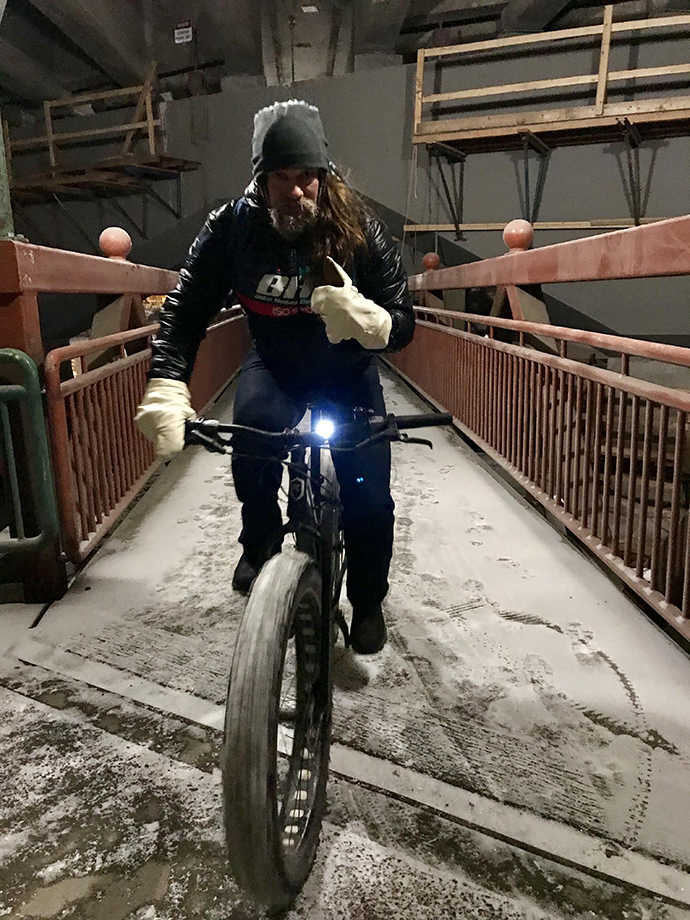
In the midst of the polar vortex, where frothing meteorologists competed over cold weather hyperbole, I had my most memorable bike rides of the season.
My home city of Calgary recently hosted the 7th annual Winter Cycling Congress, giving me a week of bike-focused learning and activity. The
Biking through the cold
It t was cold. Freaking cold. Most days hovered around -25 C, although the sun did bring some moments up to a balmy -15 C. On one of the coldest days, I found myself fat-biking with two friends on a day in which the -30 C weather chased everyone else from the trails (technically, this was outside of the “polar vortex” that engulfed the rest of the continent, but it was our longest and coldest blast of winter in years).
Riding through this kind of cold with a range of other people taught me a few things. First: Cold is relative. Comfort isn’t about absolute cold, it’s about expectations. For some people accustomed to this weather, it was no big deal. They had the right gear, the right methods for staying warm and the right attitude. People from other winter cities where this kind of weather is rare struggled a bit more. There isn’t some mythical cut-off temperature where humans stop riding. It’s all about expectations.
I also learned that it’s amazing how you can enjoy a ride even at extremely cold temperatures. With the right winter gear (on feet and hands, especially), there’s almost no limit to enjoying a ride. I often tell reluctant winter cyclists that cold is not even in the top 10 challenges of winter cycling, and the polar vortex confirmed this. As your body moves, it generates an amazing amount of heat. It can keep your body warm and comfortable even in extreme cold. Dress

What the Europeans bring
There’s an impression out there that Europeans have this whole urban bike thing figured out. Thanks to such cities as Copenhagen and Amsterdam, many North Americans have an image of all European cities as bike havens.
Yet the messages from several of the European delegates at the conference was contrary. Take this interview on the local CBC television station with Lars Stromgren, a vice-president of the European Cycling Federation. Stromgren walks the perfect line here, maintaining positivity and conviviality with an air of wisdom that never veers into condescension.
But pay attention to his message. What’s great about this interview, and with Stromgren’s presence at the Winter Cycling Congress, is the fact that he’s from Stockholm, a city that is far from a model for bike friendlness. In talking with Stromgren at the conference, he was critical of his city, which is only beginning to take cycling seriously.
Stromgren may not know this, but I think hearing the message that Stockholm is in the same boat as Calgary (or pretty much every other North American city) in trying to figure out how to make cities more bike friendly is strangely inspiring. A lifetime of being told things are better in Scandinavia has inoculated many North Americans from listening to any message from Europe. It’s like being told by your parents that you really should try to be more like your brain-surgeon sister. But to hear Stromgren say that good bike cities are a work in progress everywhere — even in the homeland of Ikea — is a relatable, inspiring message.
Oh, Oulu.
Check this photo.
It was taken by Pekka Tahkola in his home city of Oulu, and it shows the bikes ridden by students to a suburban elementary school. I’ve written extensively about Oulu, perhaps the most bike-friendly winter city on Earth, but sometimes it takes photos like to really drive home the benefits of building a city around bikes.
Takhola also showed a video from the morning commute at this school that showed streams of kids on bikes rolling toward the school in the snow. The sheer number of kids on bikes drew a gasp from the Congress crowd, who are more accustomed to seeing bleary-eyed children emerging at school from long lines of steaming SUVs. To see so many kids riding — Taklhoa reports that about 1,000 of the school’s 1,200 students ride bikes in this suburban neighbourhood — was shocking and delightful.
This is what Oulu gives us: something to aspire to.
Please subscribe to our YouTube channel.
Follow Tom Babin on Twitter, Facebook, Instagram or Medium.
You can also follow Shifter on Facebook or Medium.
Tom Babin is the author of Frostbike: The Joy, Pain and Numbness of Winter Cycling.